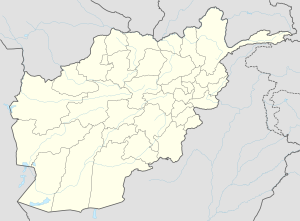Nili District
Nili
نیلی | |
|---|---|
 | |
Location within Afghanistan[1] | |
| Coordinates: 33°45′36″N 66°04′48″E / 33.76000°N 66.08000°E | |
| Country | Afghanistan |
| Province | Daykundi |
| Capital | Nili |
| Area | |
• Total | 445 km2 (172 sq mi) |
| Elevation | 2,022 m (6,634 ft) |
| Population (2005) | |
• Total | 30,058 |
Nili (Template:Lang-prs) is a district in Daykundi province in central Afghanistan.[2] The main town in the district, also called Nili, serves as the capital of Daykundi Province. The town of Nili has a small airport (heliport) with a gravel runway and a commercial radio station. The weather conditions in the winter are severe and the roads are difficult.
Nili district shares borders with volatile Gizab District, which was reported to have many Taliban insurgents roaming around. Beyond the provincial seat of Nili town, the other villages of Nili district are: Dasht, Sari Nili, Pai Nili, Ghudar, Qol Qadir, Qom Ahmad Baeg, Ijdi, Shish, Kohna Deyh and Sangmom.
Due to Nili's geographical inaccessibility and acute security problems, it was not until April 2007 that the United Nations opened an office in Nili of UNAMA (United Nations Assistance Mission in Afghanistan).[3]
Profile
District profile:[4]
- Villages: 135
- Ethnic diversity: 100% Hazara.
- Schools: 15 primary, 3 secondary, 2 high schools.
- Health centers: 5.
- Main agricultural products: almond, apricot, maize, wheat.
- Primary handicrafts: embroidery, hat making, weaving.
Notable people

- Azra Jafari, In December 2008-December 2013 Azra Jafari was named by Afghan President Hamid Karzai to be the mayor of Nili District, thus becoming Afghanistan's first female mayor.she was one of the successful mayors in Afghanistan.
- Muhammad Hussain Sadiqi Nili
- Nasrullah Sadiqi Zada Nili
See also
References
- ^ "District Names". National Democratic Institute. Archived from the original on 29 January 2016. Retrieved 6 May 2015.
- ^ "Daykundi Province ‐ Socio‐demographic and Economic Survey Highlights" (PDF). Central Statistics Organization of Afghanistan. Archived from the original (PDF) on 18 May 2015. Retrieved 5 May 2015.
- ^ "UNAMA facing new humanitarian challenges". IRIN. Retrieved 6 May 2015.
- ^ "Summary of the District Development Plan, 2007" (PDF). Nili District Development Assembly. Archived from the original on 4 March 2016. Retrieved 11 May 2015.


